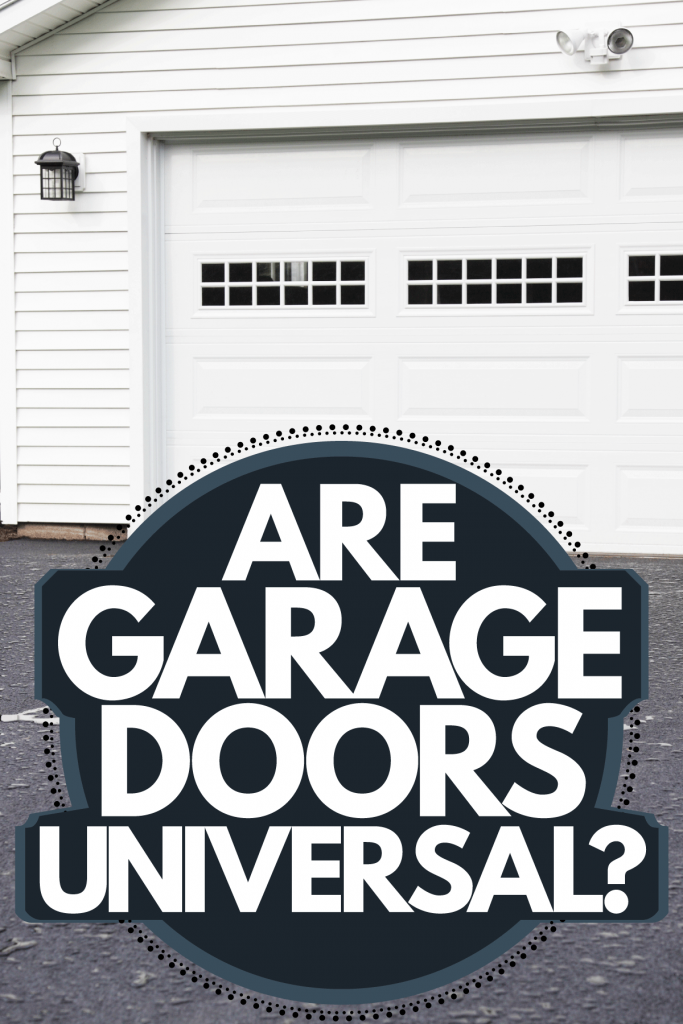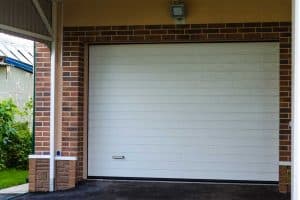Garage doors come in several shades and materials. But all these doors serve the same purpose. Garage doors are essential for keeping your garage safe and effective. Before you reinstall or upgrade your garage door, you'll need to find out if they are universal to reduce the cost of re-installation of the hardware or the door itself. We've done our research for you and here's the answer.
No, garage doors aren't universal. They come with different features, sizes, and materials. There are manually or remotely operated. Newer homes have garages wide enough to fit two or three cars. The size of your garage will determine which type of garage door you'll need to install. Whether you want to install a sectional wooden or a steel tilt-up retractable garage door, you'll need to understand which door suits your garage and pocket.
Continue reading to find out what kind of garage doors are out there. In this post, we'll mention some key things to consider when picking a garage door.

Types of Garage Doors
There are six popular types of garage doors. They come in various materials and may be changed from being operated manually to using a remote. You'll need to upgrade the hardware to get a remote-controlled door. These are the types of garage doors:
- Sectional
- Roll-up
- Slide-to-the-side
- Side-hinged
- Tilt-up canopy
- Tilt-up retractable
The most suitable materials for garage doors include the following:
- Wood
- Wood composite
- Steel
- Fiberglass
- Aluminum
Sectional
Their construction allows for a section of the garage door to open. The panels lift upwards and rest on the garage ceiling parallel to the floor. They are well-balanced to be opened manually, but the doors can have an automatic opener.
Sectional garage doors come in aluminum, galvanized steel, and timber. Manufacturers make steel and aluminum doors with a woodgrain finish. This gives the garage doors that aesthetic classic look of wood.
Roll-up
These garage doors have a sturdy one-piece construction that can sustain many open and close cycles. Roll-up garage doors have a single or double skin. The double skin curtain is stronger and offers more security. The doors come in steel and require less maintenance.
Slide-to-the-side
Capable of sliding to the side, this garage door is an example of a minimalist design that is easy to install. These doors slide and tuck on the wall of your garage and stay out of the way.
They are automatic steel or aluminum doors. Slide-to-the-side garage doors create ceiling space in your garage. With these doors, you'll have fast access to your garage.
Side-hinged
Just as the name suggests, they are hinged to the side of the garage door. These are traditional 'swing' garage doors that open outwards. They are also known as side-opening doors. Side-hinged doors are a solution if you have limited headroom in your garage.
Side-hinged garage doors are mostly made of wood or wood composite. They do sometimes come in steel. Manufacturers make the steel doors double-skinned for strength and security.
Tilt-up Canopy
Tilt-up canopy garage doors are not sectioned but come in one piece. The pivoting mechanism allows the canopy to tilt upwards parallel to the garage ceiling. The canopy will often extend out of the garage. Tilt-up canopy doors are often found in older properties. They are mostly aluminum and wood.
Tilt-up Retractable
Tilt-up retractable garage doors are an automated version of the tilt-up canopy doors. The mechanism used in these doors allows them to slide fully into the garage. The door materials are aluminum, steel, or wood.
Note: Fiberglass garage doors can be all the above types of doors. Sometimes fiberglass may only be used like window sections.
The cost of your garage door will depend on the style, color, material, window options, and/ or insulation level.
Are All Garage Door Sensors Universal?

No, not really. They all work in the same manner. But some are advertised as universal. This means that such garage door sensors are compatible with doors from specific manufacturers. Garage door sensors are compulsory in automatic garage door systems. This has been made mandatory by the law.
Traditionally, sensors were mechanical. The mechanical sensors would reverse the garage door when it came in contact with a physical object. Nowadays, photoelectric sensors are more popular.
Photoelectric sensors have an infrared beam which is usually placed 6 inches above the ground. At this level, a tire, leg, kid, or pet can be detected. The garage door won't close and automatically reverses.
Can You Get A Universal Garage Door Opener?
The answer is yes. Universal garage door openers can be found easily online and in stores. They can be programmed to open most garage doors. It's easy to program a garage door opener.
When you purchase a universal garage door remote, you'll find clear instructions on how to program it to open several garage doors. This is quite efficient and helps when you may have misplaced your keys.
Is LiftMaster Compatible With Overhead Door?
Liftmaster is compatible with Overhead door. In fact, most garage door openers manufactured in the US are compatible with each other. Manufacturers are well aware that garage door openers tend to get lost quite often.
Therefore they make most of them compatible. This doesn't mean that all remotes are identical. Each remote door opener has its own distinctive features.
Are Garage Door Remotes Interchangeable?
No, not all are interchangeable. The older garage door remotes are not always compatible with newer versions. Newer versions have upgraded memory chips. They use Wi-Fi and could be USB-charged. The older garage remotes are slower and have less chip memory.
It would be advisable to acquire a universal garage door remote. Manufacturers incorporate in these remotes old and new sensor programs. This makes them a must-have attribute for garage owners if they don't want to be locked out of their garages.
How Do You Program A Universal Garage Remote?
You can program a universal garage door in four easy steps.
- Take the cover off the remote. You'll see a button. Press and hold this button till you see the LED light come on.
- On the garage door opener press the button for the light to also come on.
- Take your remote and start synchronizing with the garage door opener. Press the remote till you hear a click sound. This means that the remote has found a code.
- Press the button on the remote to lock the code and switch off the LED light. Put the cover back on.
Your universal garage door remote has been successfully programmed. If you're a visual learner, check out this video:
What to Consider When Picking A Garage Door
There are a few things to bear in mind when picking a garage door that will help you save some money in the long run. Both double and single garage doors should have the following features:
- A space-saving design
- A secure door
- Long-lasting (probably a lifetime)
- A safe garage door (for little ones and pets)
- Considering the climate of your region
- Lighting (with or without windows)
- Convenience and practicality
- Not a DIY project but requires professional installation
- Aesthetics (a good-looking door that makes a statement)
Closing Remarks
Although garage doors aren't universal, they come in standard sizes. When upgrading your garage door, don't forget to upgrade or reinstall the garage door sensor, too. Make a point of purchasing a universal garage door remote. They are easy to program and can open more than one garage door.
Most urban homes have garages that can be seen as you drive along the street. Therefore choose a garage door that is convenient and stylish as well. Have a professional install, reinstall, or upgrade a garage door for you. These doors need to be secure and safe because they undergo a lot of open and close cycles.



